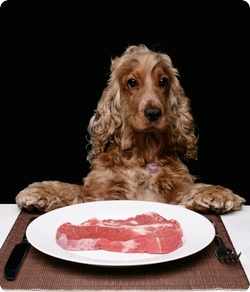Guide to raw feeding
Suddenly everyone is talking about the benefits of feeding dogs and cats a raw food diet. Open any dog or cat magazine or visit a canine or feline health website and you can almost guarantee it will be mentioned. There are dozens of new books, podcasts and videos on the subject. Even the mainstream media, led by the Daily Mail and the Guardian, has started to run long features promoting raw food and attacking processed pet food manufacturers.
What is all the fuss about?
The argument for raw feeding goes like this.
In the wild, dogs and cats, not having the wherewithal to cook, live on a raw diet. It is what they are biologically designed to eat. If you imitate this ‘wild diet’ for your domesticated pet, they will lead a healthier, longer life.
More than this, pet food manufacturers have got it all wrong. Canned, dried and pouched food – no matter how much it costs – is actually causing most canine and feline health problems. Why? Because it is made using poor-quality and harmful ingredients and because it has been cooked. The fact that is has been cooked is important as heating alters the chemical structure of food, making it hard for dogs and cats to digest it.
Canine and feline digestion in 60 seconds
Dogs and cats are carnivores. Their teeth are designed to catch and kill prey (birds, mice, rabbits and so forth), to tear the meat from the bones and to crunch those bones up prior to swallowing them.
They gulp their food because the saliva in their mouth doesn’t start to break down the food, unlike human saliva. All the digestion takes place in their stomachs, which have very strong digestive acids.
For the digestive process to work they need the enzymes and bacteria found on raw food.
Canine and feline nutrition in 60 seconds
Bones provide one-third of a dog or cat’s nutritional needs. It is completely safe for either species to eat bones, providing they are raw (cooked bones splinter).
As not all the nutrition a dog or cat needs can be found in small prey, they supplement this diet with insects, fruit, vegetables, herbs and so forth – although in different proportions.
In the wild, dogs and cats don’t eat ‘balanced meals’ or ‘complete meals’. Also, they don’t always eat every day. Instead, they get the nutrition they need over time – days, weeks, even months. This is called the ‘balance over time’ concept.
A million years of dietary history…
Three facts.
Fact one: The diet that dogs and cats would eat in the wild is the same diet that their first cousins (wolves, lions and so on) have been eating for millions of years.
Fact two: Manufactured pet food has only been around for 150 years.
Fact three: It takes over 100,000 years for a species to adapt to a major change in food.
From the above it should be clear to the meanest of intelligences that dogs and cats should be eating raw food!
The benefits of a raw food diet
A growing number of vets recognise that up to 90% of the health problems that cats and dogs suffer from are diet-related: everything from minor problems (such as allergies, dry skin and dodgy tummies) to major problems (such as cancer, organ failure and skeletal disease). There’s plenty of scientific evidence to support this opinion, too (see elsewhere on this site).
On the other hand, dogs and cats on a raw diet enjoy a glossy coat, healthy skin, lean muscle tone, a robust immune system, sweet-smelling breath, healthy teeth and gums, increased energy, better digestion, a strong heart and more energy.
They can be expected to live longer and to suffer less illness and disease.
If your dog or cat has any health issues, a switch to a raw diet will definitely benefit, and may even cure, them.
What’s wrong with manufactured dog and cat food?
The short answer is, of course, what isn’t?
Here are the main issues.
1. It is cooked. Cooking alters food’s chemical structure and kills the enzymes. As discussed above this makes it jolly difficult for the dog or cat to digest. Cooking destroys 70% of the food’s nutritional value. In order to digest it, by the way, enzymes being used for other purposes – such as protecting the kidneys – have to be re-deployed.
2. It has poor-quality ingredients. The meat is of poor quality. It can be rotten. It can be meat ‘derivatives’ or ‘by-products’ – fancy words for lungs, hooves, ears, testicles and so forth.
3. It has harmful additives. Preservatives. Colouring. Flavour enhancers. Binders. There are a lot of chemicals in dog and cat food.
4. It sticks to the animal’s teeth. This is often the cause of tooth decay and gum disease.
In conclusion
Don’t automatically believe everything that pet food manufacturers say. They are protecting a £2 billion industry in the UK alone. Instead, consider switching your dog or cat to what nature intended them to eat.


